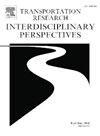考虑可持续性和城市物流利益相关者视角的双式联运网络模式选择优化
IF 3.9
Q2 TRANSPORTATION
Transportation Research Interdisciplinary Perspectives
Pub Date : 2025-05-01
DOI:10.1016/j.trip.2025.101442
引用次数: 0
摘要
在过去十年中,德国的快递、快递和包裹行业的寄货量翻了一番,达到每年40亿件,主要由化石燃料驱动的公路车辆运输。这种增长加剧了城市拥堵和排放,凸显了对铁路运输等可持续替代方案的需求,以满足气候和排放目标。本研究探讨了双式联运货运网络中最优、可持续的模式选择。具体来说,我们引入市中心枢纽,使公路和铁路模式之间的转运能够允许更多的货物转移到铁路上。使用网络流模型,我们通过将每批货物分配给火车或卡车来最大限度地降低运输成本,同时评估高速货运列车、公路通行费和补贴等运输政策对模式分割的影响。此外,我们还结合了城市物流利益相关者的目标。一项敏感性分析考察了德国包裹网络对成本、需求、速度、排放和铁路运力变化的反应。我们的研究结果表明,在许多情况下,铁路运输可以成为公路的可行替代方案。例如,卡车运营成本的小幅增加会引发向铁路运输的转变,而卡车成本超过200单位的城市税收则会导致向铁路运输的转变。列车网络容量是决定模式选择的关键因素,政策和利益相关者的决策也影响模式转换。所提出的网络流模型为评估包裹递送网络中预定义的货运政策对模式选择的影响提供了一个强大的框架,显示了铁路货运可以整合到可持续的城市内部物流供应的条件。本文章由计算机程序翻译,如有差异,请以英文原文为准。
Optimising mode choice in a bi-modal freight network considering sustainability and urban logistic stakeholder perspectives
In the last decade, Germany’s courier, express, and parcel industry has seen its consignment volume double to 4 billion annually, primarily moved by fossil-fuel-powered road vehicles. This growth increases urban congestion and emissions, highlighting the need for sustainable alternatives like rail transport to meet climate and emission goals.
This study examines optimal, sustainable mode choice in bi-modal freight networks. Specifically, we introduce inner-city hubs that enable transshipment between road and rail modes to allow more freight shifting to rail. Using a network flow model, we minimise transport costs by assigning each consignment to either trains or lorries, while assessing the influence of transport policies like high-speed freight trains, road tolls, and subsidies on the modal split. Additionally, we incorporate the objectives of city logistics stakeholders. A sensitivity analysis examines the German parcel network’s response to variations in costs, demand, velocity, emissions, and rail capacity.
Our results suggest that rail transport can be a viable alternative to road in numerous scenarios. For example, a slight increase in lorry operation costs initiates a shift to rail, while city taxes exceeding 200 cost units for lorries leads to a shift towards rail transport. Train network capacity is a critical factor in determining modal choice, with policy and stakeholder decisions also influencing mode shifts.
The proposed network flow model provides a robust framework for evaluating the impact of predefined freight policies on mode choice in parcel delivery networks, showing conditions under which rail freight can be integrated into a sustainable inner-city logistics supply.
求助全文
通过发布文献求助,成功后即可免费获取论文全文。
去求助
来源期刊

Transportation Research Interdisciplinary Perspectives
Engineering-Automotive Engineering
CiteScore
12.90
自引率
0.00%
发文量
185
审稿时长
22 weeks
 求助内容:
求助内容: 应助结果提醒方式:
应助结果提醒方式:


